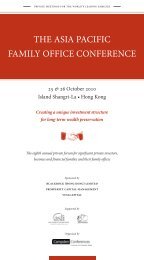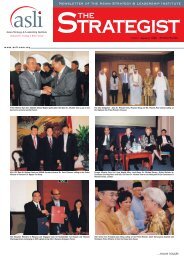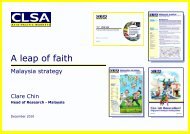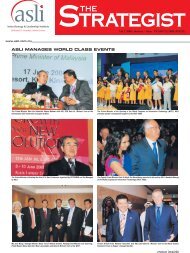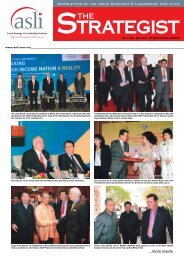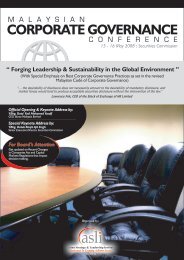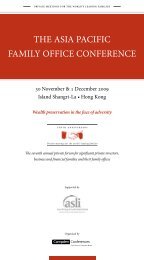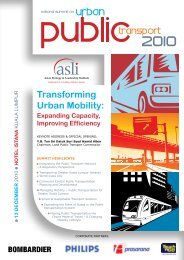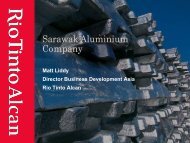This is a report of the proceedings of - Asian Strategy & Leadership ...
This is a report of the proceedings of - Asian Strategy & Leadership ...
This is a report of the proceedings of - Asian Strategy & Leadership ...
- No tags were found...
You also want an ePaper? Increase the reach of your titles
YUMPU automatically turns print PDFs into web optimized ePapers that Google loves.
THE ASIA THINK TANK DIALOGUE REPORTRebuilding Confidence, Restoring Livelihoods Conclusions 33initiatives to be revived. He pointed out that regionalgrowth was not a substitute for <strong>the</strong> international marketbut only a supplementary mechan<strong>is</strong>m. Apart from <strong>the</strong>need for regional partnerships, <strong>the</strong>re were a number<strong>of</strong> things that called for attention at <strong>the</strong> macro level.For instance, <strong>the</strong> glaring deficit in infrastructure in Asiashould be fixed. <strong>Th<strong>is</strong></strong> could be done easily as it wasnot due to <strong>the</strong> lack <strong>of</strong> resources, considering Asia hadhuge surpluses. It was acknowledged that Asia needsalso to boost its intellectual capital to complementits rich resources. <strong>Th<strong>is</strong></strong> can be done through regulardialogue among <strong>Asian</strong> counterparts. An inclusive,country-specific, sustainable-growth model approachcould be considered instead <strong>of</strong> a one-size-fits-allmodel. Champions were required to advocatefor transparency at home and abroad. Promotinginvestment transparency was clearly a priority to ensuregood governance and credibility. In <strong>the</strong> bankingand financing sector, regulation and monitoringwere necessary, to prevent <strong>is</strong>sues such as <strong>the</strong> world wasnow facing.Co-moderator Dr. Durga identified <strong>the</strong> positive pointsar<strong>is</strong>ing from <strong>the</strong> d<strong>is</strong>cussions which included how Asiahad sustained high economic growth and continuedto reg<strong>is</strong>ter a high surplus <strong>of</strong> reserves. However, <strong>the</strong>negatives outweighed <strong>the</strong> positives, he felt, especially in<strong>the</strong>se challenging times: Growing inequality, a wideningdigital divide, depletion <strong>of</strong> natural resources, lack <strong>of</strong>intellectual institutions to foster knowledge and thinking,and <strong>the</strong> increase <strong>of</strong> conflict and lack <strong>of</strong> security in ruralareas. The underlying causes included <strong>the</strong> malfunction<strong>of</strong> state and public institutions and <strong>the</strong> lack <strong>of</strong> politicalcommitment and will at <strong>the</strong> highest levels. He calledfor a streng<strong>the</strong>ning <strong>of</strong> institutions, <strong>the</strong> advancement<strong>of</strong> knowledge and political leadership. At <strong>the</strong> politicallevel and state level, addressing inequality calledfor a clear roadmap in terms <strong>of</strong> <strong>the</strong> m<strong>is</strong>sion andobjectives to ensure that it would not be a futile attempt.Foundations <strong>of</strong> moral d<strong>is</strong>cipline and commitment weregreatly required, along with long-term commitmentto institutional<strong>is</strong>e thinking.Micro aspects <strong>of</strong> rural <strong>is</strong>sues : The PrioritiesSocial enterpr<strong>is</strong>eConsensus was reached as to <strong>the</strong> divide between <strong>the</strong>economically-empowered elite and <strong>the</strong> social sector –caused mainly by mental models from <strong>the</strong> old economy;epitomized by such platforms as <strong>the</strong> World EconomicForum and <strong>the</strong> World Social Forum, two forums whichare in conflict and are now set to exacerbate <strong>the</strong> globaleconomic problem. As <strong>the</strong> divide between <strong>the</strong> socialmovement and economic agendas was widening anddeepening, <strong>the</strong>re was a need to converge <strong>the</strong>se tw<strong>of</strong>orums. There was also <strong>the</strong> need to recognize that <strong>the</strong>social side <strong>of</strong> <strong>the</strong> economy was just as important. It wasfelt that Dr. Thaksin’s foundation could initiate ways tosupport social enterpr<strong>is</strong>es and pave <strong>the</strong> way for <strong>the</strong>irrecognition as a legitimate sector ra<strong>the</strong>r than an informalsector. SEs were not set to replace <strong>the</strong> current sector,as <strong>the</strong> old economy focussed on pr<strong>of</strong>it which remaineda central goal in business ventures. However, <strong>the</strong> newmodels would allow <strong>the</strong> social sector to be operatedby marginal<strong>is</strong>ed communities and empower <strong>the</strong>m tobecome a major stakeholder <strong>of</strong> <strong>the</strong> economy. Therewere evidences showing that th<strong>is</strong> sector was a viablealternative and a means forward for <strong>the</strong> marginal<strong>is</strong>edcommunities. The new economy was set to develop fairtrade and deliver fair pr<strong>of</strong>its without impinging on <strong>the</strong>environment or impact on society in o<strong>the</strong>r ways. Suchinitiatives would fur<strong>the</strong>r encourage socially responsibleinvestors who are investing on grounds <strong>of</strong> ethical andresponsible investments.HealthcareThe <strong>is</strong>sues that affect ruralhealthcare were <strong>of</strong> interest inSwitzerland, where <strong>the</strong> leadinghealthcare companies arebased. The view put forwardwas that in healthcare,socioeconomic status oughtnot to be an important factoras availability <strong>of</strong> drugs and



